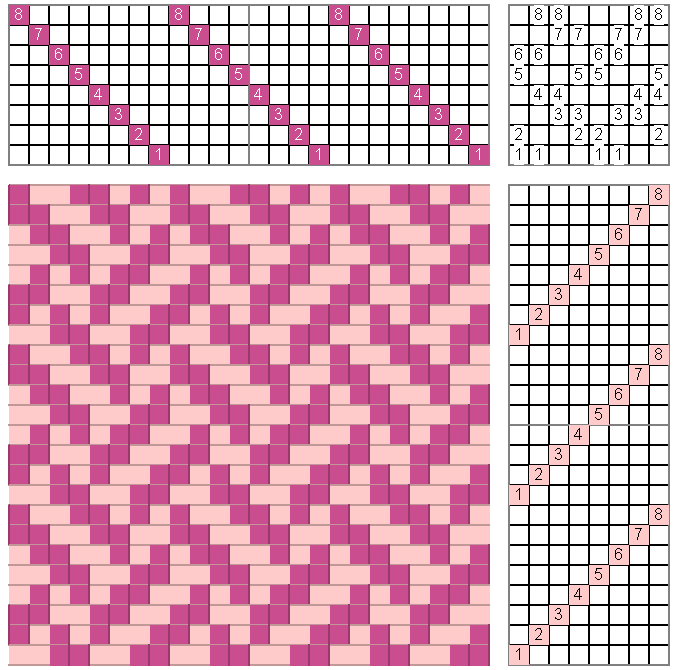Plaited Twills
Marcy Petrini
1/18/2016
At the meeting of the Chimneyville Weavers and Spinners Guild this past Saturday, the topic of plaited twills came up when I showed an example of the blog with the plaited twill Christmas fabric from 14-Dec-16.
I love plaited twills and I had woven that Christmas fabric a long time ago. More recently, I wove a shawl in a 10-shaft plaited twill. Here is the shawl, a close up of the fabric and its draft (for a better view, try to left-click, or maybe right-click, the draft and open in a new window that will appear under the current tab):



From the fabric close up and the draft, we can see why it’s called a plaited twill: each “ribbon” of left-handed twill seems to disappear under a “ribbon” of right handed twill – and vice versa – as when we braid real ribbon. The size of the “ribbons” in the plaited twill can depend on the number of shafts available.
There are two ways to approach plaited twill. One, not surprisingly as a twill; the other as a double two-tie unit.
Below is the draft of an 8 shafts plaited twills, using pattern # 358 from Carol Strickler’s A Weaver’s Book of 8-Shaft Patterns. It is threaded as a straight twill and all of the plaiting occurs in the tie-up.

The other way to weave a plaited twill is to use a threading based on a double two-tie unit weave (think summer-and-winter), shown below. The nomenclature comes from the threading. There are two shafts, 1 and 2, which serve as tie-down threads, hence the name two-tie. If we look at a repeat of the structure, shafts 3 through 8 are the pattern shafts and they alternate with a tie-down shaft; if we think of each repeat as a block, the name double comes from the fact that both tie-down shafts are used in the block. This draft is from pattern #355 from the same book. Here the plaiting occurs as a combination of the tie-up and the treadling. Explore Carol's book for many, many options on 8 shafts.

In general, using a double two-tie unit for plaited twills is more versatile than using a twill threading because we re-use two shafts. However, the treadling can be more complicated; we can see from above that two treadles alternate throughout the treadling: one has all of the shafts plus tie-down shaft 1 and the other has all of the shafts plus tie-down shaft 2.
There is another option for all of these twills. The draft above shows the threading to be ascending from shaft 3 to 8. The plaited twill from my shawl also uses a double two-tie unit but after ascending, it reverses, forming a point.
Can plaited twills be woven on 4 shafts using either one of these two methods? No; we can determine the reason if we examine the actual drawdowns. What makes the plaiting is a combination of left-hand and right-hand twills; on four, we don’t have enough shafts to have two twills intersecting when threaded as a straight draw or as a two-tie unit.
However, we can weave a twill on 4 shafts that has right and left-hand twills, the beginning of plaiting. Below is a draft of a three-thread herringbone from Marguerite Porter Davison’s A Handweaver’s Pattern Book:

There are other treadling variations on this threading in Davison's book, so the possibilities abound.
Please email comments and questions to